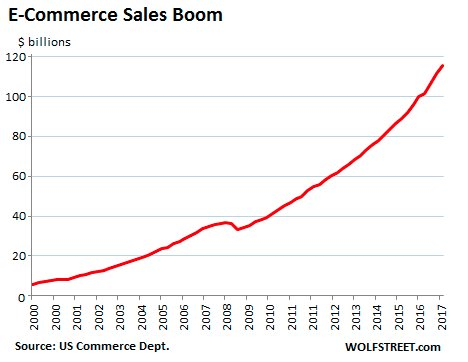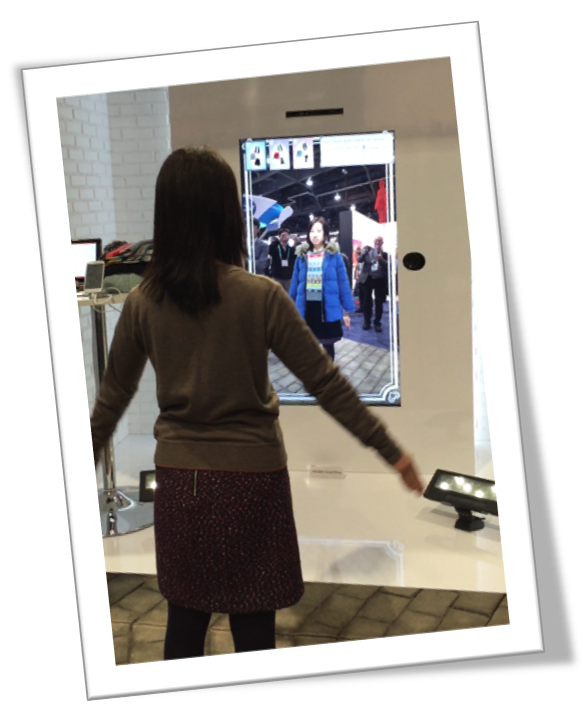 It’s looking to be a successful holiday shopping season, but that depends on who you are and what kind of business you run. If you’re a toy store, a department store, or the place where they’re often located – the mall – this may in fact be a Blue Christmas.
It’s looking to be a successful holiday shopping season, but that depends on who you are and what kind of business you run. If you’re a toy store, a department store, or the place where they’re often located – the mall – this may in fact be a Blue Christmas.
That’s because ecommerce has changed our shopping culture, altering the way consumers shop during the holidays – as well as the other 11 months of the year. The U.S. Commerce Department shows the trend begun by Amazon, way back when most people thought Jeff Bezos was out of his mind.
 Not anymore.
Not anymore.
Today, ecommerce is a force, and while malls are still busy as shoppers enjoy trying on clothes, grabbing a meal, and just socializing, the economic model has shifted to the keyboard. And package deals like Amazon Prime make it even easier to make online purchases where free delivery is simple, one-click, and guaranteed.
The phrase “Shop ’til you drop” is dated in today’s ecommerce environment.
That’s the thrust of a new Amazon TV commercial that debuted this holiday season, humanizing its delivery and distribution process with the help of a Classic Rock song (but of course!) by Supertramp.
https://www.youtube.com/watch?v=UUXgMfFfOkY
So, if you’re the mall in town comprised of traditional, old school retailers and that nostalgia shopping experience, how do you reinvent, pivot, and simply make the case that you’re still a viable place in which to shop amidst all this digital technology? That’s the question many are asking themselves in the retail sector right now, as they see ecommerce exploding.
And there’s an analogy here to the traditional media business – notably, radio – caught up in some of the same challenges in a digital world. Is there anything radio can take away from the pressures facing malls it could directly apply to its own squeeze up against new media, including satellite radio, streaming, podcasts, and video?
Two recent articles shine the light on solutions for malls that sound very familiar to those of us in the radio business. Think of the Mall of America as the equivalent of WTOP or Z100 – the best in class facing profound changes in the way consumers are spending their money. eMarketer Retail highlights the Minnesota-based behemoth and points to a number of ways MOA is rethinking and reimagining the mall experience. And in a similar story – “How the mall business can reinvent itself for the digital age” – McKinsey digs deep to uncover strategies already showing results.
Here are four ways malls are re-examining their business that have application to the radio industry.
1. It starts with research
You have to understand the consumer mindset in order to create tactics to address changing priorities. Mall of America’s VP of marketing, Sarah Townes, notes a variety of research techniques – including those who no longer shop at malls – has been instructive in understanding what shoppers are thinking.
Following the data and tracking shoppers is part of the process, and McKinsey reports that technology is providing answers, too, in the forms of apps and beacons, WiFi, point of sales info, and even security cameras, where mall operators can even analyze traffic patterns to learn where shoppers enjoy hanging out.
The Apple Store has used iBeacon technology in their stores for years, a way of better understanding customer interest, as well as providing ![]() spot-on, on-site attention. How consumers feel about in-store shopping is a variable that drives them to their laptops and smartphones.
spot-on, on-site attention. How consumers feel about in-store shopping is a variable that drives them to their laptops and smartphones.
You can’t fix what you can’t understand, and it’s interesting to note that neither article discusses research activities revolving around how malls compete against one another. Today, it’s about looking beyond mall vs. mall to better comprehend the bigger phenomena of shopping and spending.
Contrast that with most of the research conducted in the radio business – us vs. them – and you can easily see how the behavioral research being commissioned by malls has the ability to provide deeper, richer insights.
2. Technology is at the core
Rather than push back against new innovations or take a “wait and see” approach, smart mall operators are employing a variety of digital and tech tools to enrich and modernize the shopping experience.
The Mall of America has a lot of interesting digital upgrades in place, including a more robust and updated website, a chatbot incorporated  with humanoid robots to help customers, and Alexa embedded voice assistance are all part of the ways in which the biggest mall on the planet is keeping pace with shoppers.
with humanoid robots to help customers, and Alexa embedded voice assistance are all part of the ways in which the biggest mall on the planet is keeping pace with shoppers.
There’s even a tie-in with Uber to provide rides every Saturday in December, as well as activating the MyPark app to help shoppers reserve a parking space in advance of their shopping trip.
Other innovations such as allowing consumers to virtually try on clothing before even walking into a store one-ups the ecommerce experience. We saw this technology on display a couple years back at CES, and it’s now being utilized by malls.
3. It’s about the experience
Malls are learning very quickly that it’s less about anchor stores and more about creating a shopping experience that keep consumers coming back to physical shopping.
But some of this thinking comes back to acknowledging ecommerce and finding ways to make it work for traditional malls. McKinsey reports that centrally located “collection lounges” at malls allow customers to shop online and then pick up purchases at stores.
Technology in the form of apps can also help stores integrate mobile shopping with the in-store experience.
Including entertainment features at malls that go beyond shopping is event marketing at its best. Mall of America has an aquarium and an amusement park.
McKinsey notes that a medium market shopping center outside of Lansing, Michigan – the Meridian Mall – is partnering with other major draws. The mall has attracted the Michigan Women’s Hall of Fame to its shopping mecca to provide more than just lines of stores.
Via partnerships and event marketing, radio has the same ability to do more than just play the hits and attract traffic sponsorships. Over the years, connections with clubs and music venues, as well as creating off-site listener gatherings are successful methods of connecting the audience with the radio brand.
4. The new new thing
The takeaway you get from studying the mall business is they’re no longer afraid to try (and even fail at) new innovations.
McKinsey notes how mobile can create a better shopping experience, as apps can be used to personalize and plan shopping trips, provide navigation, and allow customers to more efficiently create their mall experience.

Attracting Millennials to malls isn’t a whole lot different than radio’s challenges with Gen Y. As McKinsey notes, dining and entertainment can be the gateway. “Food is the new fashion” has become an oft-spoken philosophy designed to directly reach Millennials and what they care about.
The Mall of America is re-examining its tenant strategy as well, bringing in online custom suit brand Indochino, as well as a vegan fast food restaurant, Earth Burger, to accommodate broader tastes and trends.
Loyalty programs for frequent shoppers are also being tried, offering perks like free valet parking, as well as special offerings for those who travel great distances to experience the mall.
Mall experts point to the need for agility – trying new features, analyzing the results, and tweaking and modifying from there. McKinsey calls this a “test-and-learn mindset” – something that mall operators are getting their heads around.
Just as in radio, change can move at varying paces. But in today’s new rocket-paced shopping environment, the need for new-and-now speed has never been greater.
And that goes for radio, too.
So, as you head to the mall this weekend for last minute shopping – or to return those ugly Christmas sweaters and unwanted gifts a few days later – pay attention to what malls are doing to reinvent and pivot in a digital, ecommerce world.
And then start thinking about how some of those same protocols and techniques apply to another legacy entertainment activity:
Listening to broadcast radio.
- What To Do If Your Radio Station Goes Through A Midlife Crisis - April 25, 2025
- A 2020 Lesson?It Could All Be Gone In A Flash - April 24, 2025
- How AI Can Give Radio Personalities More…PERSONALITY - April 23, 2025




Leave a Reply